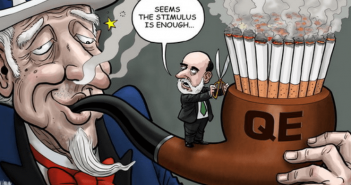- BoE decided to leave the policy rate at 0.1%.
- The rise of the delta variant won’t hurt the economy.
- Fed taper talks boosted the USD.
The US dollar has gained a boost from many Fed speakers who have talked up tapering, while the Bank of England has decided to keep its policy rate unchanged.
BoE policy remains unchanged
As expected, the Bank of England maintained its monetary policy settings, holding interest rates and the Asset Purchase Facility at 0.1 % and £895 billion, respectively.
However, only one MPC member, Michael Sanders, voted against QE, which was a critical reason for a minor boost to the British pound.
–Are you interested to learn more about automated forex trading? Check our detailed guide-
The UK central bank indicated its willingness to impose negative interest rates in the accompanying monetary policy statement.
The Bank of England went on to say that a negative interest rate is not the preferable policy.
Nonetheless, rumors of negative rates proved crucial in discouraging bulls from putting aggressive wagers and limiting gains for the GBP/USD pair.
COVID spread fears
The UK economy has grown strongly in recent months as lockdown measures have been reduced due to the rapid speed of vaccinations and earlier lockdowns aiding in the containment of the virus.
Even though the delta variety has been spreading, new cases have been declining in recent days. This is unlikely to have harmed economic activity in England because all constraints were lifted substantially.
Boost in USD after the Fed Taper talk
Yesterday, we had an opportunity to examine how much the market relies on the Fed’s monetary policy expectations. The biggest cause of volatility in US and European markets and the majority of the world’s markets is speculation regarding the timing of the Fed’s taper.
Yesterday’s disappointing employment figures combined with hawkish remarks from Fed policymakers boosted the USD.
The ADP report
According to the independent ADP report, private-sector employment growth was only 330K, half of projected and lower than last month’s data. This job growth rate is concerning, given more than 6.5 million employees remain unemployed compared to pre-pandemic levels.
Not to mention the natural expansion in the labor market over these 16 months.
The ADP findings dampened expectations for Friday’s official Nonfarm Payrolls statistics and fueled speculation that the Fed would have no need to reduce its stimulus.
The ISM Services Purchasing Managers’ Index, on the other hand, was stunned with a sky-high score of 64.1 points — including an increase in the Employment factor. The figures provide hints about Friday’s Nonfarm Payrolls.
The data also put significant pressure on the currency while failing to provide considerable support to the stock market. Investors were concerned about a slowing in corporate earnings and sales growth.
Fed taper talks
Federal Reserve Vice Chair Richard Clarida said he favors announcing a taper already this year and sees upside risks to his inflation forecast.
While he did not support an outright cut in the Fed’s bond purchases in 2021, he stated that it is already a step toward tightening.
Furthermore, Clarida stated that the requirements for a rate hike might be met in late 2022, which, coupled with an increase in US Treasury bond yields, provided some support to the USD.
According to prominent Fed hawk James Bullard, QE’s coming dismantling would pave the way for a rate hike as early as next year, if required.
Referring to the QE program, Dallas Fed President Robert Kaplan mentioned that, “as long as we continue to make progress in July numbers and in August jobs numbers, I think we’d be better off to start adjusting these purchases soon”.
–Are you interested to learn more about forex signals? Check our detailed guide-
He went on to say that tapering throughout “plus or minus” eight months would offer the Fed “as much flexibility as possible to be patient and flexible on the Fed funds rate.”
He stressed that it is “important to separate discussion of the Fed funds rate from discussion of our purchases.” His remarks on purchases are not intended to imply that he wants to take more aggressive action on the Fed funds rate.
In addition, another FOMC member, Christopher Waller, hinted a few days ago that the Fed is obligated to begin reducing balance sheet purchases by October.
The previous day’s concentration of hawkish comments drastically changed the dynamics of the US currency. As a result of Clarida and Bullard’s comments, the dollar index rose 0.5 %, indicating a rise on Thursday morning.
The present Fed standoff between hawks and doves and bulls and bears on the dollar is set to peak on Friday.
The labor market statistics could be a powerful justification for one side or the other, but stock markets and the greenback can remain in tight ranges until then.
Looking to trade forex now? Invest at eToro!
67% of retail investor accounts lose money when trading CFDs with this provider. You should consider whether you can afford to take the high risk of losing your money.



